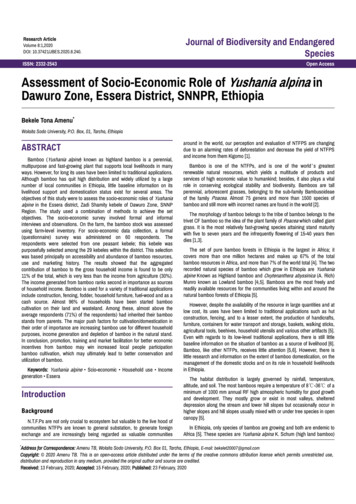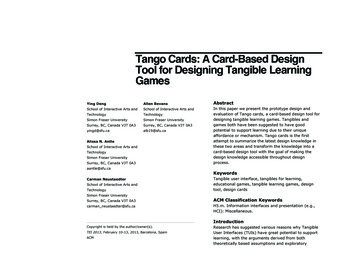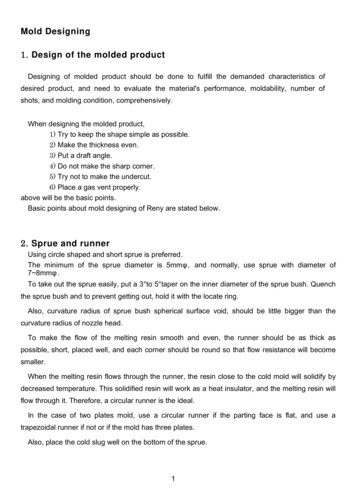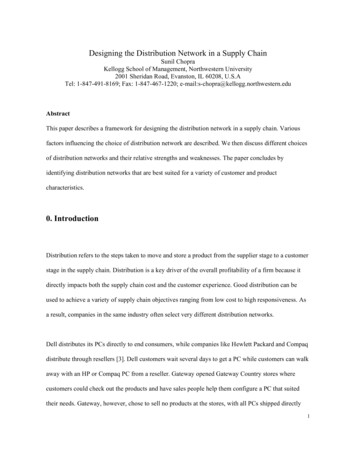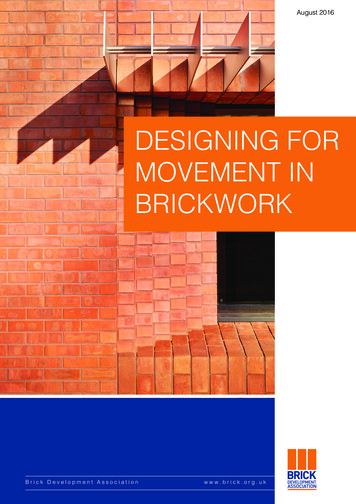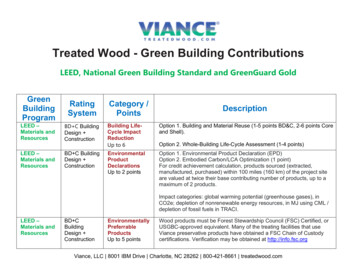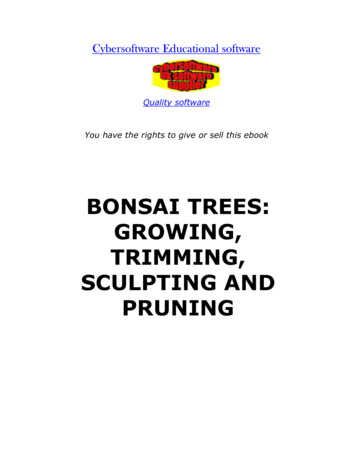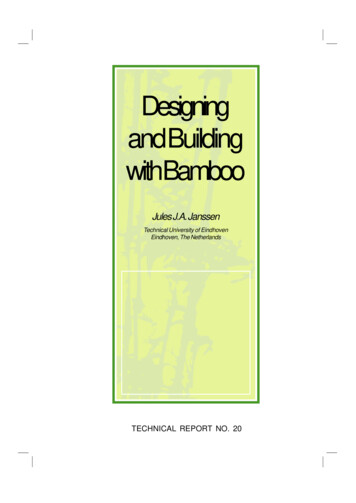
Transcription
DesigningandBuildingwithBambooJules J.A. JanssenTechnical University of EindhovenEindhoven, The NetherlandsTECHNICAL REPORT NO. 201
designing and building with bamboo International Network for Bamboo and Rattan 2000All rights reserved. No part of this publication may be reproduced or transmitted inany form or by any means, electronic or mechanical, including photocopy, recording orany information storage and retrieval system, without permission in writing from thepublisher.The presentation of material in this publication and in maps that appear herein does notimply the expression of any opinion on the part of INBAR concerning the legal statusof any country, or the delineation of frontiers or boundaries.ISBN 81-86247-46-7EditorArun KumarDesign and productionArt Options2
AcknowledgementsiIn the 26 years of working with bamboo, I have met several good people, working in thefield of bamboo, from all over the world. Many of them have become my cherishedfriends. First among these are those from the National Bamboo Project (later Funbambu)in Costa Rica; I could list enough names to fill up this page. Apart from these CostaRican friends, I will mention here only four people: Wim Huisman, my professor andfirst promoter; Walter Liese, who was a member of my Ph.D. committee and with whomI have spent many enriching hours working on bamboo in several places; RamanujaRao, with whom I have had as close a working relationship as two scientists can have;and Arun Kumar, who has done a tremendous editing work on the typescript of thisbook. I would also mention here that this book would never have been written but forthe understanding and support of my wife Loek.J.J.A. Janssen3
designing and building with bamboo4
PrefaceoOver the past few years, several friends and peers had suggested that I write a book onbuilding with bamboo. Each time such a suggestion was made, I used to recall the wisewords of a professor who was famous for his lectures. Whenever pressured to write abook based on his brilliant lectures, he used to decline, saying: “If I present my lectures,my students will hear also my uncertainties, my doubts, the limits of science; but if Iwere to write them down, then these are exactly what would become invisible.”Then, why did I write this book now? There were some very persuasive argumentsfrom certain quarters in favor of writing it. One was that the insights and knowledge onbamboo collected during my 25 years of research, guidance of projects and visits tobamboo-growing countries all over the world should not be allowed to go unrecorded.Another was that other areas – timber, for example – too started in a similar way withone author writing a book while the area was still small enough to be captured by theefforts of one. Finally, I thought that some information contained in my large collectionof gray literature should be revealed to all interested researchers.This book has its origin in an e-mail I received in December 1996 from the HawaiiChapter of the American Bamboo Society, with an invitation to present a series of lectureson all aspects of bamboo. An exchange of ideas followed through several e-mails aboutthe scope of the lectures, the topics to be covered and the time to be spent on each. Itwas decided that an emphasis should be laid on bamboo’s mechanical properties, jointsand structures. I spent a considerable part of January-June 1997 preparing lecturematerials and charting out the course.5
designing and building with bambooI reached Hawaii in July, and spent the first two weeks presenting summaries of thelectures in three minor islands. On the third week, on the Big Island, the tempo reallypicked up. The event started with a demonstration on bamboo jointing to a large audience.This was followed by a three-day seminar, with six hours of lectures each day, involvinga large group of participants whose enthusiasm and dedication were contagious. Over150 people had assembled there, paying on their own for travel and accommodation,and listening to lectures on bamboo six hours a day for three days!The effort that went into the preparation of that lecture series culminated in this book.It took some time to bring the lectures into the shape of chapters, but doing that hasgiven me a great sense of satisfaction. I hope the readers will find this result of myendeavors useful and interesting. I thank the Hawaiian Chapter of the American bambooSociety without whose invitation to lecture this book might never have been.Although the emphasis here is on designing and building with bamboo, I have includedtwo chapters – on Technology Transfer and Job Creation – so that the publicationprovides a wider perspective on bamboo. I believe that this should be so because bamboois not just a plant or a material; in many parts of the world, bamboo is a vital part of theliving heritage that links yesterday with tomorrow.Jules J.A. Janssen6
Contents1. IntroductionThe Bamboo PlantBamboo in its SettingThe Structure of BambooCompetitiveness of BambooMechanical PropertiesUses of Bamboo91012161721252. PlantationsForests, Homesteads and PlantationsEcological Aspects of Bamboo PlantationsPlantation Management333439433. Durability and PreservationNatural DurabilityFundamental RulesBamboo and Preservation515254564. Mechanical PropertiesBamboo, a Hollow TubeNature’s Structural DesignBending TestsBamboo and Shear StressWind Load on Bamboo CulmCompression TestBending vs. ShearBucklingRules of ThumbEarthquake Resistance63646666687071747676777
designing and building with bamboo5.Modelling and CalculationsThe Art of ModellingAllowable StressesDesign of JointsBuilding on Tradition79808183876.JointsClassification of JointsSome ExamplesTheory of Joints89901081127.International StandardsThe Relevance of StandardsTowards an International Standard1171181208.Bamboo as ReinforcementFiber Reinforced Cement MortarBamboo Reinforcing in ConcreteBamboo for FormworkSoil Reinforcement1271281301331339.Bamboo HousingSocial AspectsTechnical AspectsGuidelines for a Housing Project13713814516310. Transfer of TechnologyThe ContextThe Means16516616611. Job CreationBamboo CraftBamboo and Sustainable DevelopmentBamboo and Employment17117317517612. Costs and BenefitsBamboo PlantationBamboo Enterprise181182185References189Further Reading1978
Chapter OneIntroduction9
designing and building with bambootTheBambooPlantIn their natural habitat, bamboo plants grow from seeds or rhizomes. The rhizomesystem is very important to bamboo. As bamboo does not have a central trunk as intrees, the rhizomes provide the foundation. McClure (1966) has described the bamboorhizome as a segmented (with nodes), complex subterranean system. Bamboo rhizomescan be broadly classified as pachymorph (sympodial) or leptomorph (monopodial). Inpachymorph rhizome system, the apex of a rhizome gives rise to a shoot that growsinto a culm, the woody stem of bamboo. Such culms grow close together as a clump. Inleptomorph rhizome system, the lateral bud from each internode develops into a culmor a rhizome. As the apex of the rhizome grows horizontal to the ground, the clump ofmonopodial bamboos has a spreading habit, with each culm growing at a distance fromthe other.Fig. 1 shows on the left a young shoot, protected by a series of sheaths, which will falloff as the shoot grows into a mature culm. In many cases, these protective culm sheathsare covered with tiny hairs sharp enough to pierce human skin and, in several species,toxic enough to cause skin irritation. Most bamboos are hollow, as can be seen inFig. 1 (on the right). In the hollow inner area, some horizontal partitions called“diaphragms” can be seen (towards the bottom on the right-side picture). On theoutside, these partitions are denoted by a ring around the culm. A diaphragm and thering on the outside together form a “node”. Branches grow from these nodes. The partbetween two nodes is called an “internode”. The internodes of most bamboos arehollow; that is, they have a “cavity”. The wall of the culm is called simply the “culmwall” (Fig. 2).In general, bamboo species have luxuriant foliage: the plant is one of the top producersof biomass, producing about 10 tons per hectare. According to an estimate, bambooaccounts for one-quarter of the biomass in tropical regions and one-fifth in sub-tropicalregions.10
Fig. 1: A young bamboo shoot – outside (left) and inside (right)(From CIBA Review, 1969, No. 3, p. 7; by permission of the Company Archive of Novartis AG, Basel, Switzerland)4123465Fig. 2: The parts of a culm(1 diaphragm; 2 ring; 3 node; 4 internode; 5 culm wall; 6 cavity)11
designing and building with bambooFig. 3: Bamboo in landscaping (Japan)BambooinitsSettingBamboo has the remarkable ability to create an “ambient”, in the artistic sense of theterm. Fig. 3 shows how bamboo can set the tone of a landscape. It forms a marvellouscontribution to the beauty and an improvement to the environment (bamboo’s role inthe environment will be discussed in detail in Chapter 2). The beautiful composition ofleaves and culms, often in rich colors, has inspired poets and painters from the ancientto the modern times. In many modern shopping centers and office buildings aroundthe world, bamboo’s stately elegance makes it a cherished component of architecturaldesign. A harsh winter can severely harm bamboo because it is a plant for tropical andsub-tropical environs. But even in countries with cold climates – such as the WesternEuropean nations and the US – bamboo can be found in many gardens and parks as thebamboo lovers in these places seem to have developed an instinct for growing speciesthat can survive cold winters.12
introductionA bamboo grove or plantation can be viewed as the production site of a building andengineering material; but it is also a haven for the living. Many birds build their nests onbamboo, and one can easily meet among bamboos animals like an iguana or an armadillo,or the smaller ants, snakes and scorpions. In a forest setting, larger animals such aspanda, orangutan and elephant frequent bamboo stands. Some rare flowers, herbs andmushrooms can be found inside bamboo groves, the edible “princess fungus” thatcontains 21 amino acids being one example.One must not forget to adequately emphasize bamboo’s role as a means for erosioncontrol, riverbank protection, landslide prevention and land rehabilitation. Bamboo’sextensive network of rhizomes and roots binds the top one foot of soil, which is criticalfor land productivity (Fig. 4), and effectively resists erosion by forces of nature such aswind and water. There are cases reported wherein bamboo was planted to successfullyprevent the erosion of a riverbank and thus protect a village from being washed away.Fig. 4: The root system of bamboo (the white scale is 150 mm long)13
designing and building with bambooFig. 5: Sasa bamboo, the green coverWhen the bamboos had grown, not only the village was safe but also the villagers wereable to sell the culms and make a profit (Singh 1995).There are some species of bamboo that can very effectively provide a green cover forthe earth and protect the soil. Sasa bamboo (Fig. 5), for example, is about 100-200 mmhigh and is ideal for covering an area to protect it from erosion and sunburn. Its numerousroots keep the soil together, while its leaves protect the soil against the sun. It will alsoimprove the soil through the biomass produced: the blanket of fallen leaves is effectivemulch to keep the moisture in and an organic fertilizer to rejuvenate the soil.14
Fig. 6: A field in Costa Rica being readied for bamboo propagationWhile most plants are multiplied by seeds, bamboo is an exception. In general, plantsflower at least once a year to produce seeds. But most bamboos flower rarely – once ina period varying from 15 to over 100 years. It is not practical to wait that long forpropagation and therefore, bamboo is propagated mainly through cuttings. One placewhere green culms are extensively used for cuttings is Costa Rica (Fig. 6). Here, greenculm lengths, with branches trimmed, are put horizontally on the soil. After 2-3 weeks,new sprouts start to grow at nodes, where a branch has been trimmed. Each sprout willhave a root growing downwards and a shoot upwards. After some time, the originalculm can be cut into pieces and all young sprouts replanted in a nursery. In Asia, culmcuttings are two or three internodes long. These are planted vertically into the soil, withone node deep into the soil. Roots will start growing from the lower node, and brancheswill sprout from the upper ones. Other methods that are in practice in different parts ofthe world include offset method, rhizome method, layering, macroproliferation andtissue culture.15
designing and building with bambooTheStructureofBambooThe microstructure of culm wall can be seen in Fig. 7. The outside of the culm wall (leftside of the picture) is dense, as can be seen from the dark color, and only about a quarterof a millimeter thick. This layer contains much silica, a good material to protect theplant, but a nuisance for tools as silica blunts their sharp edges within a short time. Thedark spots, decreasing from left to right in the cross-section, are cellulose fibers togetherwith vessels. Cellulose acts as reinforcement, similar to steel bars in reinforced concreteor glass fiber in fiber-reinforced plastic. These fibers are concentrated near the outside.The stiffness (the resistance against bending) that this distribution pattern creates isten percent more than the one that a more even distribution pattern could offer – anexcellent example of the structural design acumen of Mother Nature (imagine a steelFig. 7: The structure of bamboo (specimen size is 6 x 6 mm)16
introductiontube with high tensile steel on the outside and normal mild steel on the inside!). Thevessels take care of the transport of liquids during the life of the bamboo. The materialbetween the dark spots is called “parenchyma”, and it is the matrix in which the fibersare embedded (like the concrete between the steel bars). Approximately, a bambooculm has 40% fibers, 10% vessels and 50% parenchyma.While inspecting the structure of bamboo, one aspect readily catches our attention:bamboo does not have any “rays” like the ones present in wood (best seen in woods likebeech as dark spots on the surface of a sanded plank). Rays are places for the transportand storage of food, mostly sugar, but they weaken the material. Consequently, bamboois stronger than wood, especially in shear (this will be discussed in detail in Chapter 4).CompetitivenessofBambooThere are several plantations in bamboo-growing countries where bamboo is harvestedjust like timber (Fig. 8). However, can one expect bamboo to be as economicallycompetitive? A simple calculation will explain this. Assume the approximate price of an8-meter bamboo culm to be US 1.50. If the volume of woody material in the culm –taking into account only the culm wall and not the cavity inside – is calculated, thisprice would be US 105 per cubic meter. It has been verified that, because of itshollowness, bamboo’s effectiveness as a beam is 1.9 better than a wooden beam. Hence,for wood to be economically as competitive as bamboo, it should not cost more thanUS 105 4 1.9 US 55 per cubic meter. However, wood used for beams costs muchmore than this, emphasizing the competitiveness of bamboo in structural use.In most of the bamboo-growing countries, trade in bamboo culms is well established.For example, about 25 million bamboo culms arrive every year in the dock seen in Fig.9 from the northern part of Bangladesh. These come as rafts floating down the river, atransportation process that lasts about three weeks. During this time, the transportationcrew lives in the hut set up on top of the raft. Fig. 10 shows a regular wholesale marketwhere the bamboo culms traded. Here, culms are segregated according to their thickness,straightness, etc. for sale to building contractors and others.17
designing and building with bambooFig. 8: Harvested bamboo culms in a plantation in ChinaWhen considering a material for structural use, the first question that arises is about itssafety. Fig. 11 shows a comparison between bamboo, timber, steel and concrete in termsof their behavior under stress. The stresses, with the symbol “s” (pronounced “sigma”),are plotted on the horizontal axis. To make stresses between these different materialscomparable, the value of the stress in the material when the building is in normal use istaken as the unit. This is indicated by the term “s use” (also called the “allowable stress”)and is about 140 N/mm2 for steel and 10 N/mm2 for timber. In each of the three diagramsin Fig. 11, a formation like a hill can be seen. This is the area of stresses at failure during18
Fig. 9: A dock near Dhaka, Bangladesh, from where bamboo culms are transportedFig. 10: A wholesale bamboo market near Dhaka, Bangladesh19
designing and building with bambootests, the middle part of the “hill” indicating the mean stress at failure (denoted by “smean”). Each hill also shows an “s” value, which is the standard deviation indicatingwhether the results of a test are widespread or not. Technicians consider the stressunder which 5% or 2.5% of the specimens fail as the limit, and the allowable stress shallbe at a safe distance below this limit. These limits are indicated as s5% or s2.5%. Onthe vertical axis, we see the value “p”, which is the chance that a stress will occur. If a hillis wide and flat, the “p” is low; if a hill is narrow and steep, the “p” is high.The lowest diagram is for steel, a material that is produced using a very controlledprocess and hence, bad specimens are very rare. It shows a narrow and steep hill, indicatingp concretess 5%susesmeanp wood/bambooss 5%susep steelssuse s2.5% smeanFig. 11: A comparison of safety of bamboo and other materials20smean
introductionthat failure under stress occurs in a narrow range indicated by a small value for “s”. Thismeans that the allowable stress (“s use”) can be at a short distance from the stress atfailure. The diagram in the middle for wood and bamboo, which are natural materials,shows a wide variety of stresses around the mean stress at failure. In these materials,specimen quality varies widely from very bad to very good. Because of this uncertainty,one finds a large distance between the stress at failure and the allowable stress. The topdiagram is for concrete, which is between the other two as far as safety is concerned. Innormal circumstances, the use of steel is economical because of the short distancebetween allowable stress and stress at failure, signifying the optimum use of the material.The use of timber and bamboo, on the other hand, is less optimal since the allowablestress is very low when compared with stress at failure.In the case of a disaster like a hurricane or an earthquake, however, the stresses will getmultiplied. They may become double the allowable stress. In such cases, stresses insteel will come into the area of failure, but not in timber and bamboo. This means thatsteel structures will suffer much damage, while most structures of timber or bamboowill remain in good condition. A bamboo house is a good place to stay during a hurricaneor an earthquake (provided the house has been built with proper care).Another comparison between the materials is shown in Fig. 12. Two questions are dealtwith here – how much strength and how much stiffness (resistance against deformation)does concrete, steel, timber or bamboo give? The diagram shows that, as far as strengthis concerned, concrete is the worst, followed by timber (the green bars in the diagramare calculated as the strength divided by the mass per volume or the density). Steel isthe best and bamboo the second best. In terms of stiffness, the fourth place is forconcrete, third for timber, second for steel and the first place is for bamboo (the brownbars in this diagram are calculated as the E-modulus divided by the mass per volume orthe density).MechanicalPropertiesMechanical properties will be dealt with in detail later, and the following is only a shortintroduction. The most important mechanical property is the mass of the material per21
designing and building with bamboostrength/mass per volumestiffness/mass per volumeconcretesteelwoodbambooFig. 12: Strength and stiffness comparisonunit volume (which is the density) expressed usually in kg/m3. For most bamboos, thedensity is about 700-800 kg/m3, which varies with the quality of the site of growing, thespecies, the position in the culm, etc. Why is this property important? The greater themass per volume, the heavier the bamboo because more molecules are present in unitvolume. In other words, the greater the mass per volume, the denser the material.Evidently this results in properties that are desirable in most situations. This relationbetween mass per volume and strength gives some rules of thumb. For instance, thebending stress at failure (in N/mm2) can be estimated as being 0.14 times the mass pervolume (in kg/m3).A notable feature is that failure in bending of bamboo is not a failure. This seeminglyillogical statement needs an explanation. If a bending test is performed on a beam oftimber or any other building material, first a “crack” develops and then the beam breaksinto two pieces – a real failure. Bending tests, such as the long-term bending test shownin Fig. 13, were performed at the Technical University of Eindhoven from 1981 till1988. The tests showed that “creep”, which is increasing deformation on the long term,does not occur in bamboo, while most timbers are well known for this.Fig. 14 shows a bamboo after “failure”. If the specimen was a timber beam, it wouldhave cracked and broken into two. In bamboo, however, all fibers along its length still22
Fig. 13: Bending tests for bamboo (Technical University of Eindhoven)Fig. 14: Failure in bending for bamboo (Technical University of Eindhoven)23
designing and building with bambooexist without any damage. The only thing that has happened is that the bond betweenthe fibers has broken down and, consequently, the circular form of the cross-sectionhas lost its strength. Remarkably, if the load placed on it is taken away, the bamboospecimen will return to its original straight form. This phenomenon has great practicalimportance. If a bamboo house has suffered from a heavy earthquake, some bambooelements in it might show some damage. But the house will still be standing and habitable!Some temporary repair measures – such as winding a rope around the damagedbamboo – are all that would be required till the damaged posts or beams can eventuallybe replaced.It was mentioned earlier in this chapter that bamboo is stronger than wood in shear.Fig. 15 shows a test on shear, performed in Costa Rica, according to a test methoddeveloped at the Technical University of Eindhoven in the 1970s. Shear is important injoints that connect one bamboo with another. Nails, bolts, pins and similar fastenersare used in such joints. In all these joints a hole is made in the bamboo, and the fasteneris put through this hole. When in use, a tensile force from this fastener will be appliedtowards the end of the bamboo joint, resulting in shear. The test method in Fig. 15 hasFig. 15: Test on shear (Technical University of Eindhoven)24
introductionbeen selected as the best after a long series of comparisons among different test methods(it is also an excellent example of North-South technical cooperation!).UsesofBambooBamboo can be put to thousands of uses. Since most of the trade in bamboo articleshappens on the informal market, annual value of the global trade in bamboo products isdifficult to determine. However, a conservative estimate puts it at US 10 billion. Thissection will examine some of the major uses of bamboo.Fig. 16: Bamboo scaffolding on a building in Shanghai, China25
designing and building with bambooBamboo scaffolding is a rich tradition in many Asian countries such as China, India andThailand. Bamboo scaffolding is well known for its capacity to resist hurricanes. Casesare known wherein bamboo scaffolds survived hurricanes that blew away steel ones as ifthey were matchsticks. Bamboo scaffolding now is suffering from competition withsteel scaffolding, because the latter is an industrial product with standardized dimensions,which make it quick to erect and dismantle. In this respect, bamboo scaffolding needssome technical upgrading. There are some aspects that resist development. For instance,in most cases, the labor force that puts up scaffoldings is organized in guilds that areclosed to people who do not belong to certain families. This structure is a guarantee forgood transfer of traditional knowledge but a major obstacle for bringing in moderndevelopments.Bamboo is a superb option for good and cheap housing. Fig. 17 shows one of the 1987prototypes of the National Bamboo Project in Costa Rica. It is an example of goodFig. 17: A prototype bamboo house in Costa Rica26
Fig. 18: Prefab concrete foundation for bamboo columndesign: overhanging roof, a structure of bamboo culms, walls of panels of split bambooswith cement mortar on both sides, and ventilation through the upper part of the walls(this building method was later simplified and improved). The use of bamboo in housingis discussed in detail in Chapter 9.The capacity of people to invent their own solutions for difficult problems plays animportant part in development. Fig. 18 shows an example of such a solution. Everybodyknows bamboo should not have any prolonged direct contact with the soil, particularlywet soil. But a bamboo column needs to be anchored securely to the foundation inorder to keep the house down during strong winds. The staff of the Costa Rican NationalBamboo Project invented a prefabricated foundation. The bamboo column is extended27
designing and building with bambooFig. 19: Panels being prefabricated for mass housingat the lower end using concrete, which penetrates the bamboo for about 400 mm (thelength of an internode) and extends outside the column for over 600 mm. The concreteis poured into the bamboo culm kept in upside-down position. A piece of PVC tube,cut lengthways and wrapped around the bamboo is being used as formwork. This solutionis commendable because it is a simple and effective answer based on a sound analysis ofthe problem.If bamboo is considered for mass housing, then it becomes necessary to look intoprefabrication options. Fig. 19 shows a panel factory in Costa Rica. Imagine a situationwhere 1 200 houses have to be built annually, and each house needs 17 panels. This28
introductionmeans that one panel has to be produced every six minutes, given an 8-hour shift perday and 250 working days – really an industrial process. Most people think of bambooas a rural commodity for the small farmer and his family. While this is true to a largeextent, there is an industrial side for bamboo as well. More such industrial processesneed to be developed if bamboo is to contribute towards housing the one billion homelesspeople in the world. It must also be remembered that industries provide large-scaleemployment, which is an economic necessity in most developing countries.The last statement leads to the role of bamboo in job creation. Bamboo is a materialthat provides several job creation opportunities because many products can be madefrom it with low capital investments. The precondition for this is a social structure,mainly in the villages, that fosters cooperatives, and education and training in makingbamboo products. Fig. 20 shows a chair, a good example of furniture that can be madeat village level. Only simple tools are needed; more essential is a good design that takesinto account not only the aesthetic value but also the way the product can be made, itsFig. 20: Bamboo furniture (Costa Rica)29
designing and building with bambooFig. 21: Bamboo handicrafts (Japan)durability and, most importantly, its marketability. In most cases, the last item is thebottleneck. In Europe and elsewhere, some people do buy products made in developingcountries, but this can never amount to structural support for the economy of bamboogrowing countries. For that, there has to be bamboo products that can compete withproducts made from wood or even plastic. The chair shown in Fig. 20 does not meet thestandards of the markets in Europe or the United States. Unfortunately, there is a longway to go to design and develop bamboo products that meet export requirements. Fig.21 shows a more simple item, two pieces of handicraft for tourists. This really is apromising area, provided there are tourists around. Here too a good design is essentialbut the quality level can be lower, as tourists buy items with a less critical mind andmore for souvenir value. A sound system of cooperatives is needed to ensure sure thatthe profit does not remain in the shop in town but reaches the people in the village whocreate the artefacts.PLYBAMBOOPlybamboo, which is plywood made of bamboo, provides a good avenue for job creationat village level. Weaving of split bamboo strips is a fairly long tradition and in the case of30
introductionplybamboo, it takes the road towards a modern industry. One unique appeal of theprocess is that it can still start at the village level, but end in a modern factory.Fig. 22 shows a group of villagers, mostly women, involved in weaving bamboo mats.They can do this on days they cannot work on their land, or during their leisure. Anorganization in the form of a cooperative is needed to effectively manage the work andensure equitable distribution of profits. From a social point of view, work like this isvery good for community health – people of a disadvantaged group (women) are workingtogether in a relaxed atmosphere to ea
to the modern times. In many modern shopping centers and office buildings around the world, bamboo’s stately elegance makes it a cherished component of architectural design. A harsh winter can severely harm bamboo because it is a plant for tropical and sub-tropical environs. But e
